Innovation challenge software allows innovation managers to create “challenges,” where they post about specific company pain points or goals and invite employees (or outside user groups) to submit their best ideas to solve them.
In our experience, these challenges help companies receive a high volume of ideas relevant to where they are currently trying to innovate.
To do this effectively, however, high-quality innovation challenge software should allow innovation managers to:
Give adequate background on the “why” behind the challenge by including resources such as articles, videos, and FAQ sections. Innovation managers should also be able to share what's been tried previously and what factors employees need to consider before replying.
Customize idea submission forms and ask employees to share specific details about their ideas. This encourages employees to think through their ideas, resulting in more carefully crafted submissions.
Establish deadlines to ensure employees are focused on the most urgent challenges.
Publicly display replies to challenges for other employees to see. Because employees can see each other's replies, they can work together to identify weaknesses and make improvements.
Have employees provide feedback on ideas, move the most promising ones forward, create evaluation workflows to test their potential, and plan implementation projects.
There are many innovation platforms available that help innovation managers collect ideas. However, some lack the features needed to create challenges with the important features above. Others may be stronger in idea collection but lack the workflows to actually implement ideas, which is also an important step in innovation management.
So, we put together this guide to discuss six innovation challenge software that meets the criteria above. We begin with our solution, InnovationCast, and show you how to create challenges, enable 24/7 idea collection, and design workflows to launch ideas.
1. InnovationCast
Customizable Innovation Challenge Software to Turn Employee Ideas into Innovations
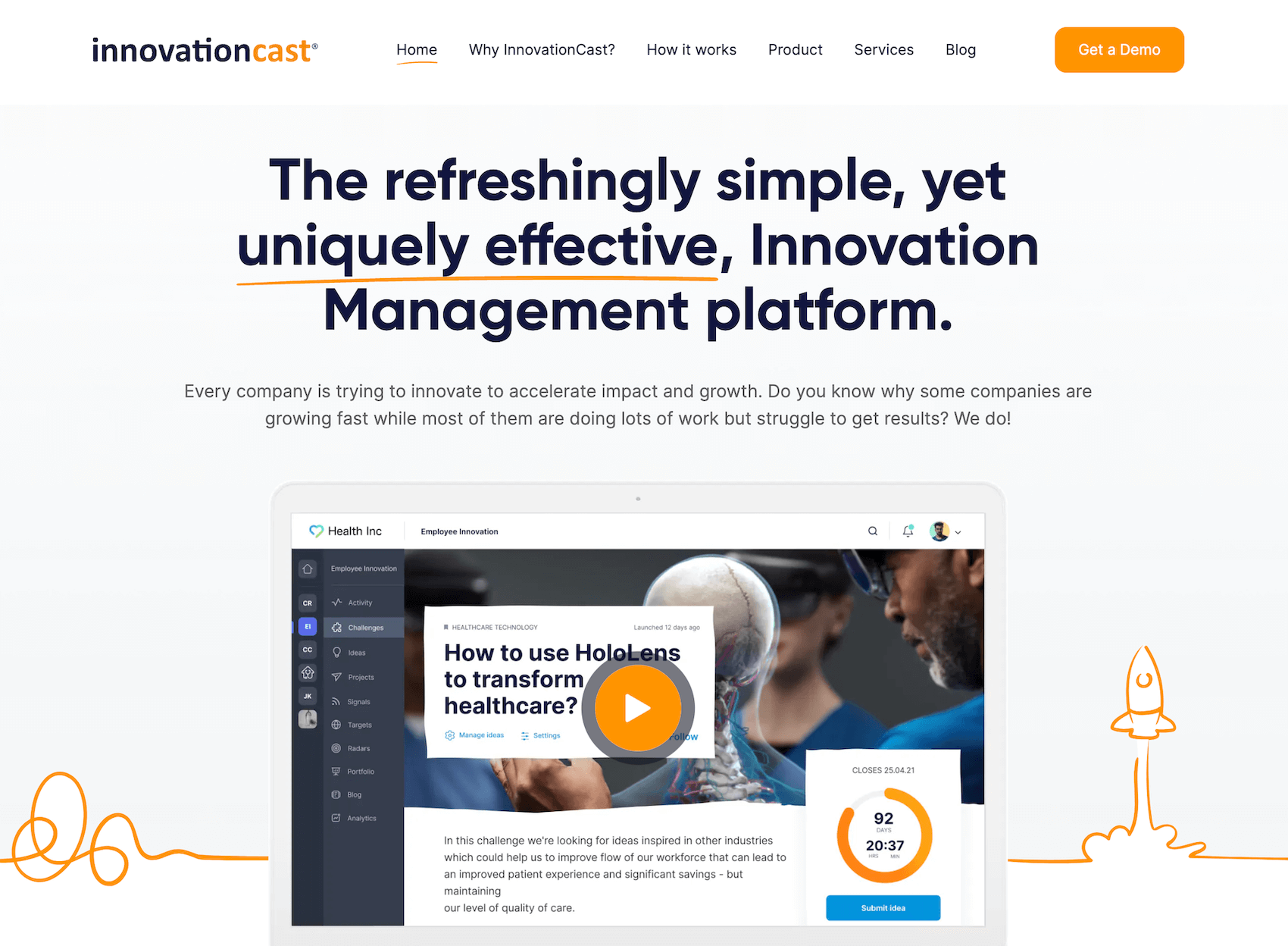
InnovationCast is a customizable innovation management software that supports ideas through their entire lifecycle — from collection to assessment, validation, implementation, and impact tracking.
During onboarding, our team shows you how to create detailed challenges around the types of ideas you’re trying to collect and use articles, videos, images, and attachments to provide employees with more information about your challenge.
We also give you access to customizable onboarding emails and automated drip campaigns that encourage everyone inside your organization to reply to your challenges and leave feedback on other people’s replies. This lets you harness your organization’s collective intelligence and facilitates the continuous creation and improvement of ideas.
To help you move forward on these ideas, we show you how to create different types of idea evaluation workflows and push ideas into implementation.
These workflows are like starting points that walk you through what you need to do during each step of an idea’s lifecycle to implement it, whether it’s sketching an MVP, running a financial risk analysis, or conducting customer interviews.
Below, we briefly discuss InnovationCast’s features so you can get an idea of how our solution works.
Innovation Challenges
Innovation managers can create challenges around specific company problems and priorities they’re focusing on.
When setting up challenges, managers can provide employees with more information about these problems and priorities using articles, videos, FAQ sections, and other resources. They can then set deadlines to ensure employees focus on the most urgent challenges.
For example, let’s say the healthcare innovation department is tasked with reducing patient wait times in their hospitals.
They can create a challenge with details about the main causes of delays, average patient wait times, and the number of doctors on shift at once. This gives employees the context needed to identify inefficiencies with existing operations and suggest improvements that align with the company’s available resources.
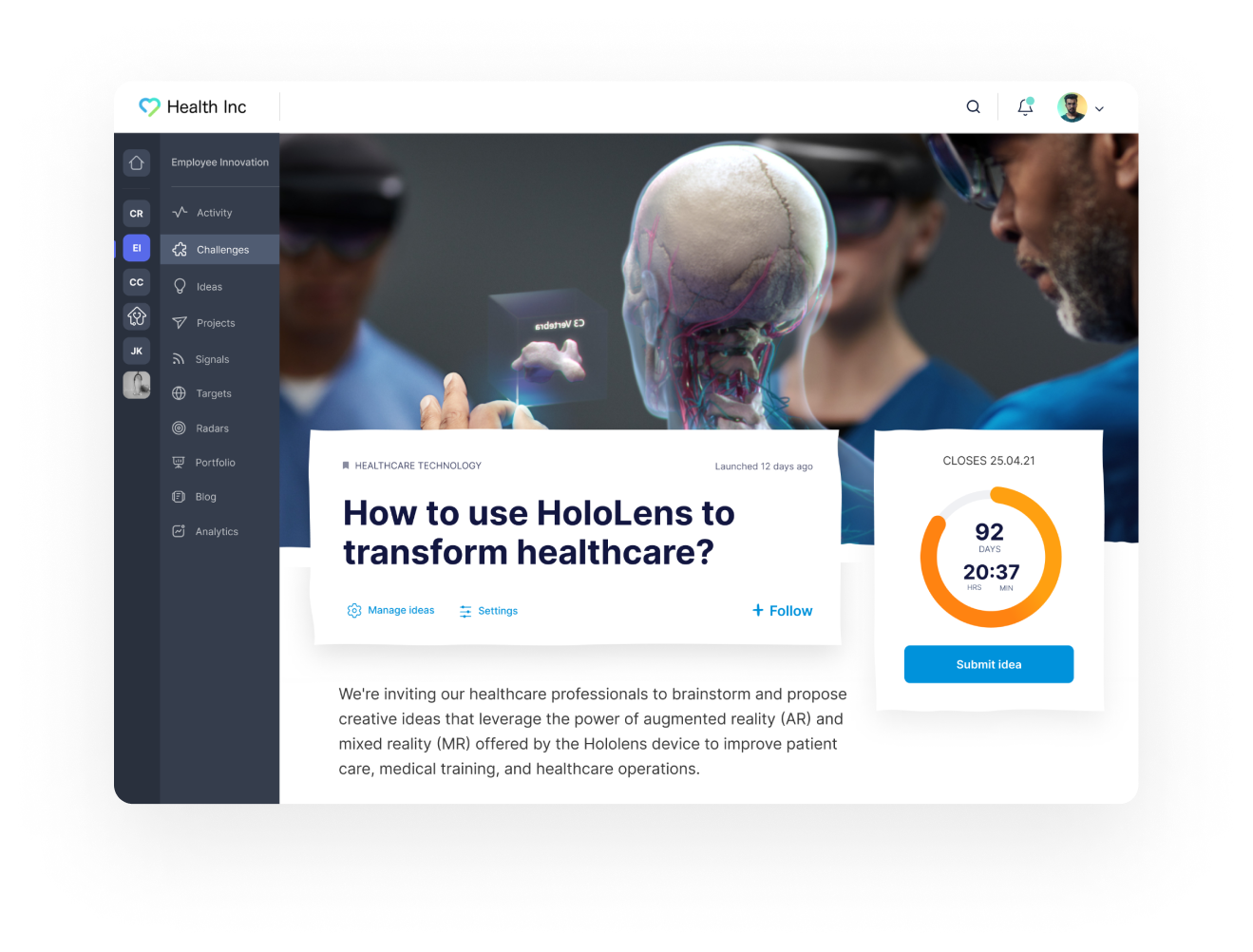
Or, suppose the customer success team of a help desk provider is trying to reduce the number of customers churning after the free trial. They can create a challenge and inform employees about the resources they provide to explore and learn the software during the trial, and the most common questions they receive from customers. Then, employees can suggest improvements to the trial product or training resources to keep customers on board.
Our challenges feature allows innovation managers to get very specific with the details of their posting, which results in a higher volume of well-thought-out idea submissions.
In addition, employees can follow certain challenges and get notified of updates — whether new ideas are submitted or managers take ideas forward. This involves employees who still want to participate in innovation efforts but might not have original ideas.
Collaborative Feedback Features
While posting challenges is an effective way to receive a high volume of relevant ideas, it’s important to remember that employees rarely reply to challenges with “perfect” idea submissions. Ideas might have a lot of potential, but they also have weaknesses and considerations that managers need to work through before implementation.
With this in mind, we designed InnovationCast with collaborative feedback features that allow innovation managers to crowdsource idea feedback.
When an employee submits an idea, everyone else can see it on their feed and vote by saying if it “Looks great,” “Needs work,” or whether the user is “Undecided.”
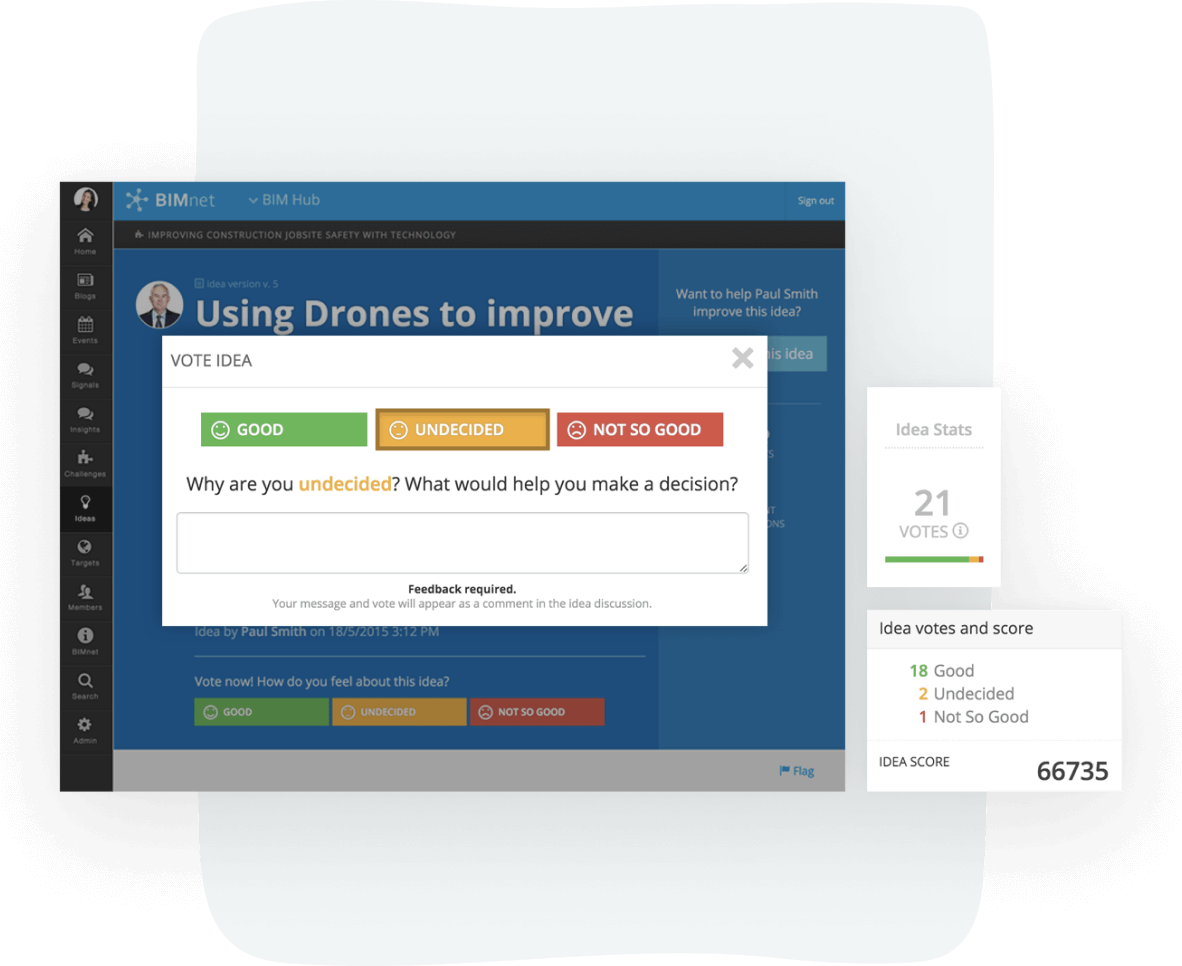
We then prompt voters to say why they think an idea looks good or needs work, which ensures that voters are providing original idea contributors with actionable advice they can use to improve their idea.
Original idea contributors can then mark feedback they receive as a "Significant Contribution." This helps managers quickly identify feedback that plays an important role in shaping ideas and saves them time reading discussion threads.

Note: Our “Significant Contribution” feature also acts as public recognition for users who provide helpful feedback, which can incentivize employees to join feedback discussions. In addition, innovation managers can use our badges and rewards system to thank employees for leaving thoughtful commentary.
Read more: How to Create a Collaborative Innovation Process and Network
Additional Idea Collection Features
Beyond posting time-constrained challenges, it’s a best practice to open up idea collection and let employees submit ideas relevant to the innovation strategy at any time.
This is why we designed InnovationCast with the following features:
“Always On” idea collection with custom submission forms
Signals & Scouting to centralize news sharing
“Always On” Idea Collection with Custom Submission Forms
In addition to challenges, Innovation Cast lets innovation managers use “Always On” idea collection model to collect ideas from employees anytime. These open calls for ideas work well when collecting ideas on broader, less urgent initiatives.
Crucially, however, the “Always On” idea collection tool in InnovationCast isn’t a context-less call for any and all ideas. As we’ve explained before, context-less, passive idea collection is a recipe for poor idea collection. We recommend innovation managers establish accepted categories for ideas so employee submissions are always related to company goals.
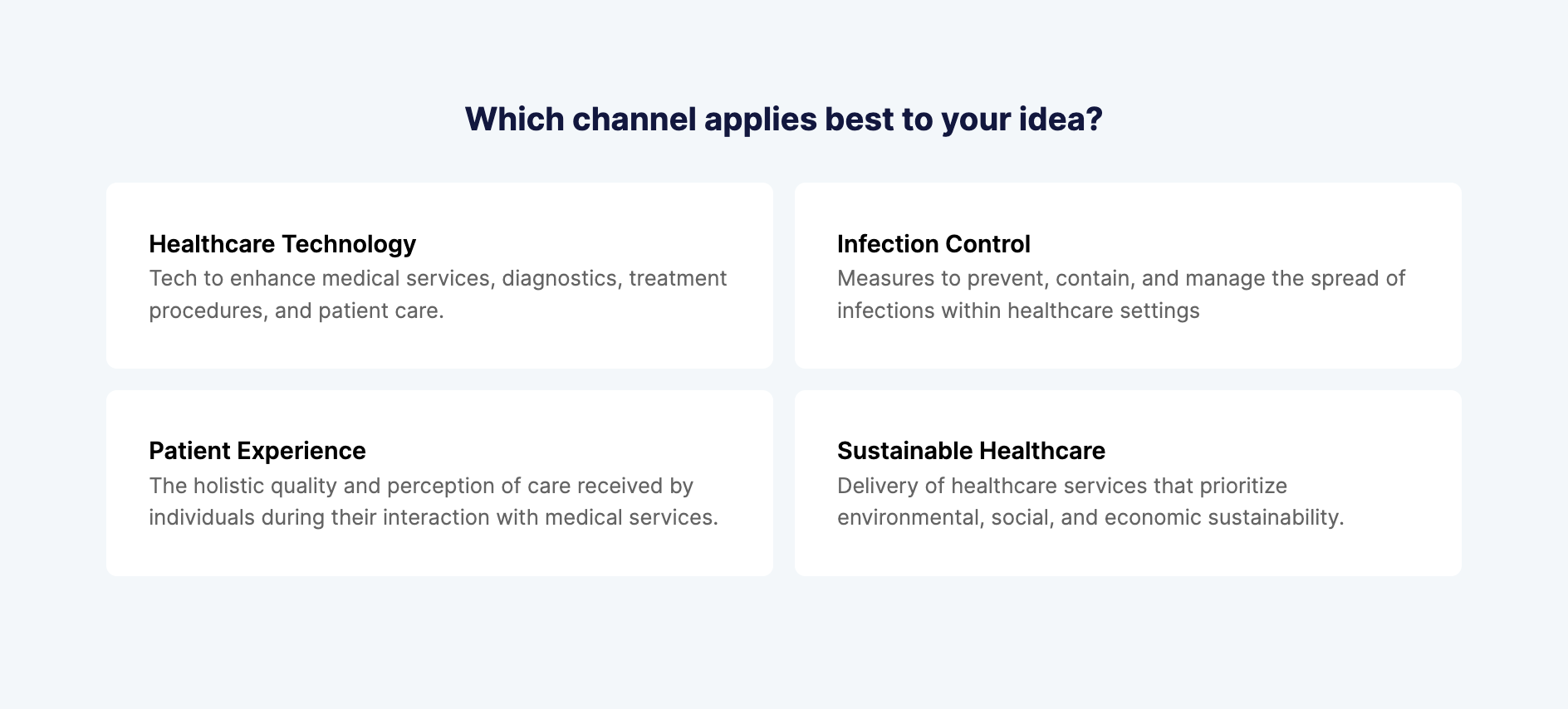
Innovation managers can add detailed questions to idea submission forms and prompt employees to dig deeper into the feasibility of an idea and how it can benefit the organization. These questionnaires can weed out irrelevant, impractical, or low-quality submissions.
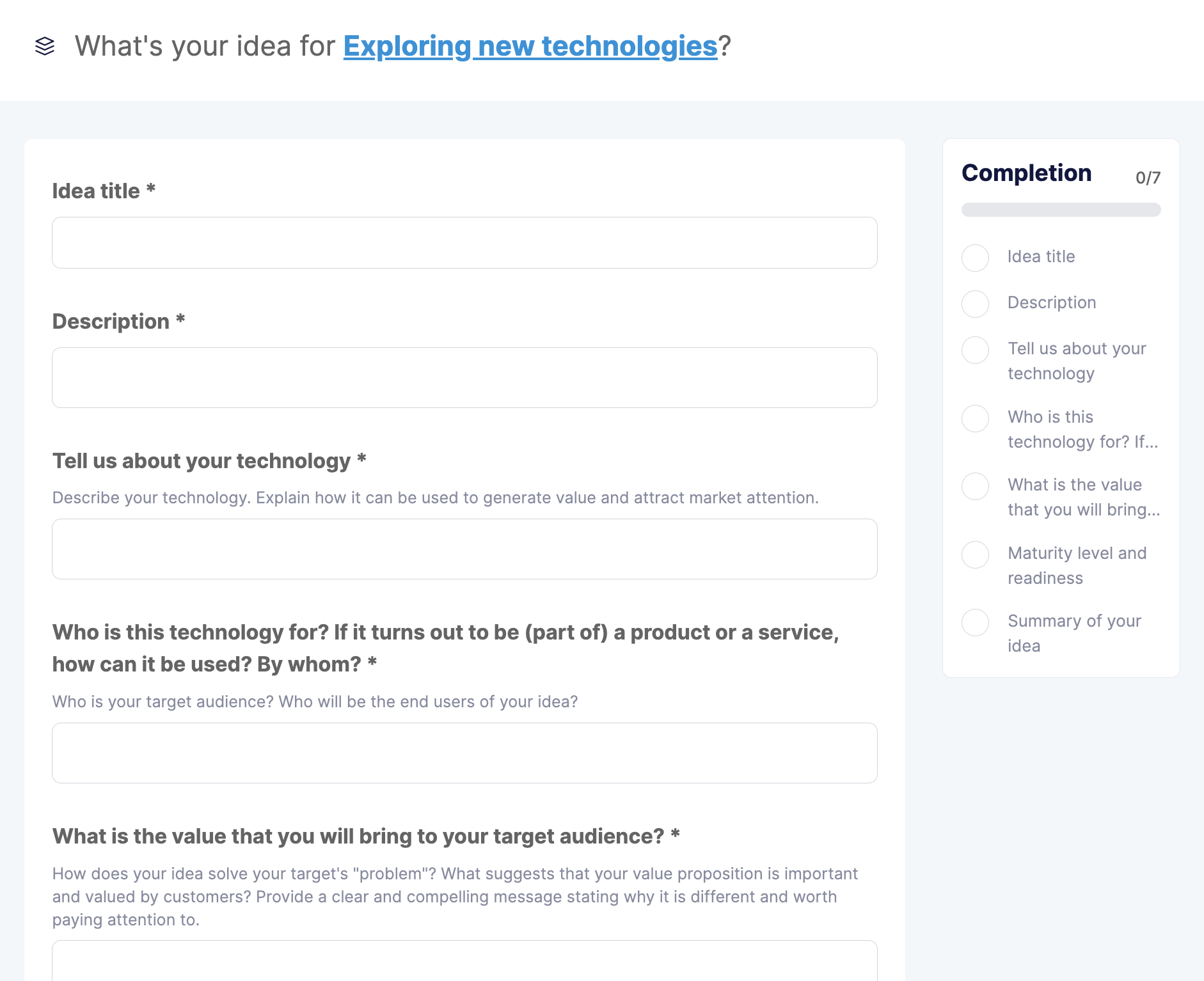
Innovation managers can choose to display ideas publicly so everyone else can review ideas, leave feedback, and work alongside original authors to improve submissions.
Signals & Scouting to Centralize News Sharing
Even if employees don’t have original ideas to share, you still want them to participate in innovation efforts — as consistently involving employees in projects lets you create and sustain an organization-wide innovation program.
A good way to do this is to allow them to share relevant industry news with the rest of the organization, as this can fuel the creation of new ideas.
We support this with our Signals & Scouting feature. When employees come across articles, videos, or press releases they believe everyone else should know about, they can share them via Signals & Scouting.
Here, we also prompt employees to categorize resources and answer specific questions about the Signal they share (the main takeaways, potential benefits, the customers it impacts, etc.).
The rest of the organization can see these resources when they scroll through their feed.
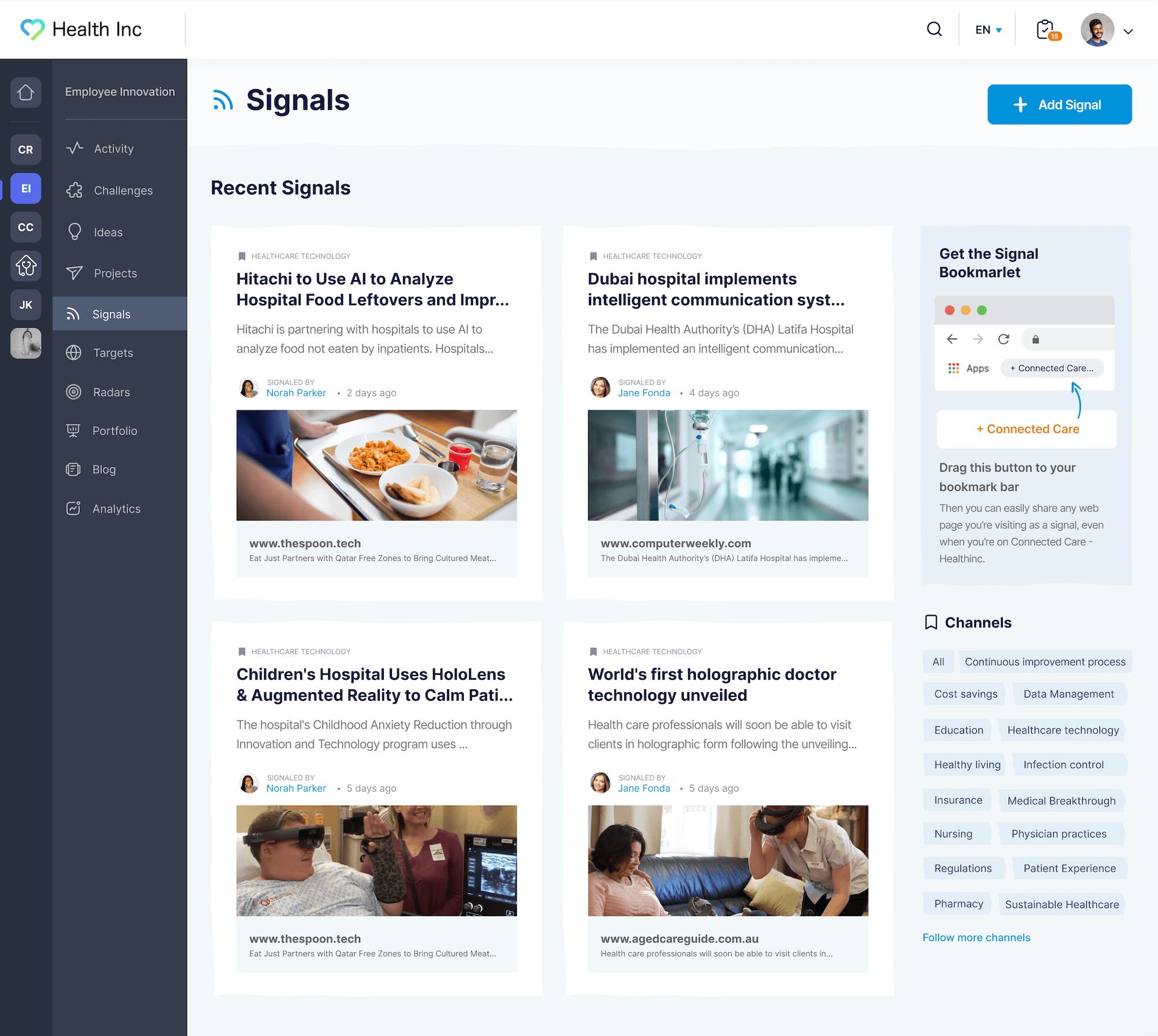
For example, if an employee reads a press release about a direct competitor launching a new mobile app, they can share it, and everyone can brainstorm whether it’s worth developing their own mobile app.
Read more: How to Encourage Innovation in the Workplace
Tools to Push Ideas into Implementation
An important part of getting employees to respond to your challenges is actually showing them what happened to their ideas after submission. If employees can’t see their ideas in action or at least know they are being considered for implementation, they tend to lose interest in replying to future challenges.
So, to facilitate the implementation of ideas, InnovationCast provides innovation managers with the features required to support ideas through their entire lifecycle:
Idea evaluation workflows: Innovation managers can design evaluation workflows (and create different workflows for different types of ideas), customize the tasks and experiments within workflows, and determine who’s involved. This way, teams know what tasks they are responsible for to validate ideas and determine if they’re worth pursuing.
Project planning: Innovation managers can plan implementation tasks and assign them to certain employees and teams. From here, they can see if projects are on track for launch or require special attention.
Portfolio management: Innovation managers can monitor the progress of ongoing projects. Our system also stores past projects (both successful and unsuccessful) so they can use these lessons to improve your innovation processes.
Innovation managers can see the actual impacts of innovation initiatives by pushing ideas through evaluation workflows, planning implementation tasks, and referencing past projects. Employees can also see their ideas come to life, which boosts morale and encourages them to respond to future challenges.
If you’d like to learn more about how you can use InnovationCast’s customizable idea evaluation workflows to implement various types of ideas, feel free to check out the guide below.
Read more: How to Develop an Innovation Process to Launch New Ideas
Book a Free InnovationCast Demo
This was just a quick summary of how InnovationCast can help innovation managers create challenges and collect high-quality idea submissions.
Book a free demo to see our challenges feature and learn more about the tools to evaluate and implement ideas.
2. Wazoku
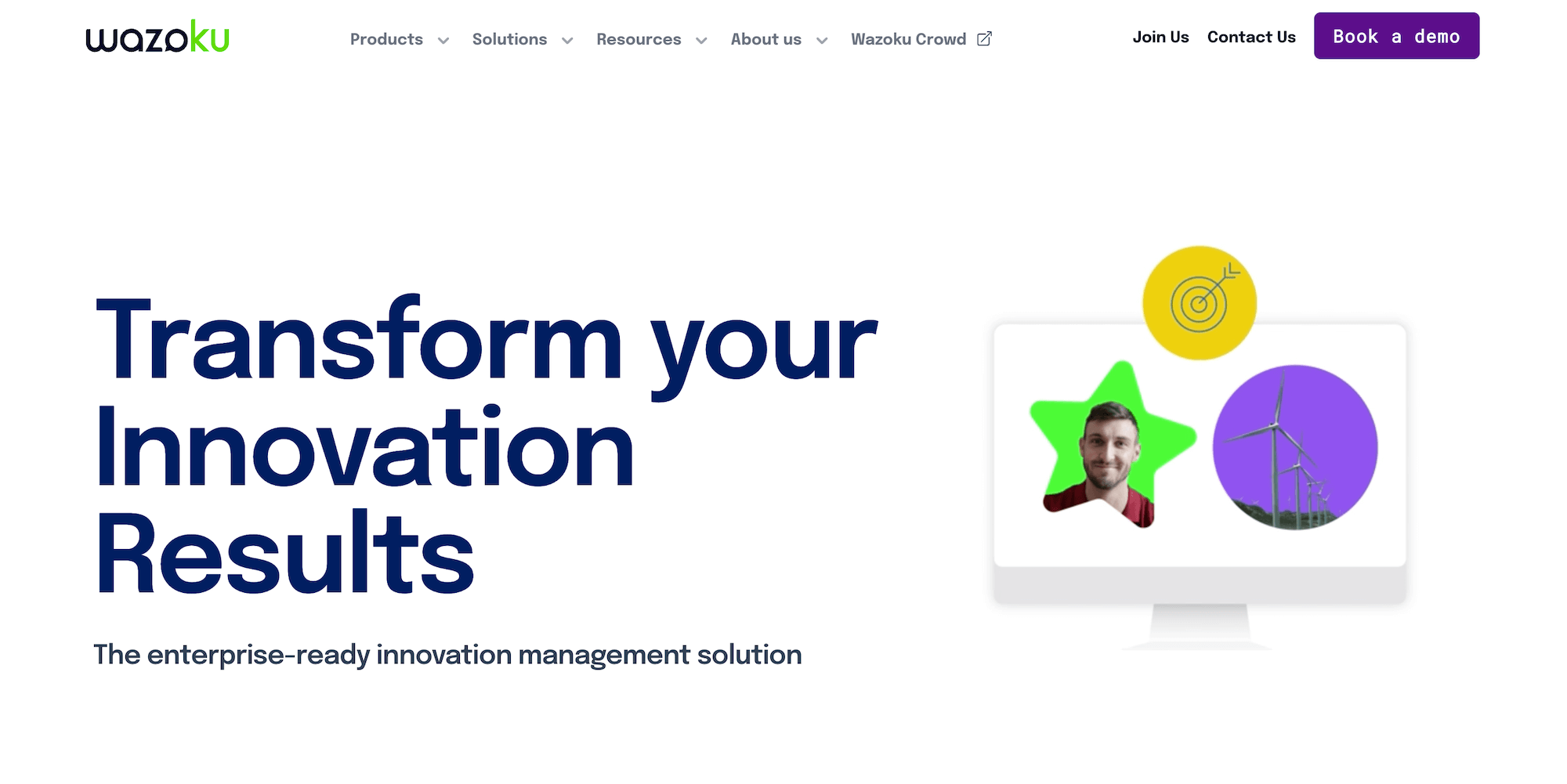
Wazoku is enterprise innovation management software that has worked with brands such as Microsoft, NASA, Shell, and Mastercard. Like most solutions, it offers free demo calls before onboarding, during which users can review its features, create challenges, and collect ideas.
Their challenges feature works similarly to that of InnovationCast. Innovation managers can call employees to submit ideas related to company goals. They can then add supplemental resources to these postings and set deadlines so employees know which challenges are most urgent.
In addition to idea collection, these are the core functionalities inside Wazoku's innovation management platform:
Co-creation — When an employee replies to a challenge, others can view it on their dashboard, leave comments, and work with the original author to brainstorm ways to improve their idea.
Employee rewards — When someone submits a good idea or gives their colleagues helpful feedback, innovation managers can use Wazoku's reward and gamification functions to give them public recognition, PTO, cash bonuses, movie tickets, or other rewards.
Insights & Pulse surveys — Innovation managers can send detailed surveys to users inside (and outside) the organization and gather their thoughts on specific topics.
Wazoku Academy — Innovation managers can request the help of Wazoku’s innovation experts to train their employees on innovation best practices.
Pricing
Wazoku doesn't list a price on their website; you must book a demo with them for a quote.
3. Brightidea

Brightidea is another company that offers innovation management software with helpful idea collection features. One feature is Program, which is essentially their version of InnovationCast’s challenges.
Innovation managers can inform employees about the priorities and initiatives they’ve been assigned and attach documents and articles to their postings to provide more information. From here, employees can submit ideas and work with colleagues, stakeholders, and other subject matter experts to improve them.
In order to promote innovation and continuous improvement beyond their Program feature, Brightidea offers the following functionalities:
Idea box — This is similar to our “Always On” feature. Innovation managers can allow employees to submit ideas anytime and establish accepted categories to ensure submitted ideas are related to specific goals and priorities.
Lab — This is a place where innovation managers can see all idea submissions and work with the entire organization to decide which are worth pursuing.
Transformation — This is similar to InnovationCast’s Experiments feature. Innovation managers can test the potential of ideas by assigning tasks to employees and tracking outcomes to see if they are worth pursuing.
Ecosystem — Innovation managers and stakeholders can connect with outside parties and ask for help to improve innovation processes and decision-making.
Pricing
Brightidea doesn’t share their pricing on their website; however, many users report that plans start at $59 a month.
Read more: 6 Brightidea Competitors & Alternatives Review Guide
4. Ideanote

Ideanote is an idea management software with a challenges feature: innovation managers can create posts about topics they are trying to innovate around and invite employees to submit ideas. They can also create custom submission forms that prompt employees to provide more details about their ideas.
In addition to idea collection, Ideanote also has features that support the assessment, validation, and implementation of ideas:
Engage — Innovation managers can engage employees, stakeholders, and outside groups in innovation efforts by nudging them with email notifications.
Manage — Everyone can see submitted ideas and work together to improve them.
Measure — Innovation managers can measure the success of innovation projects by using a variety of analytics features.
Automate — Innovation managers can create automated workflows and notifications based on specific events.
Automatic translation — If companies have employees located across the world who speak different languages, they can use Ideanote’s automatic translation feature. This way, employees can effectively communicate and work together, even if they don’t speak the same language.
Pricing
Ideanote offers three packages:
A free plan that supports up to 10 members.
The Business Plan costs $49 to $859 monthly and allows you to host up to 1000 members.
The Enterprise Plan costs $2,899 per month and allows you to invite an unlimited number of users.
5. Orchidea
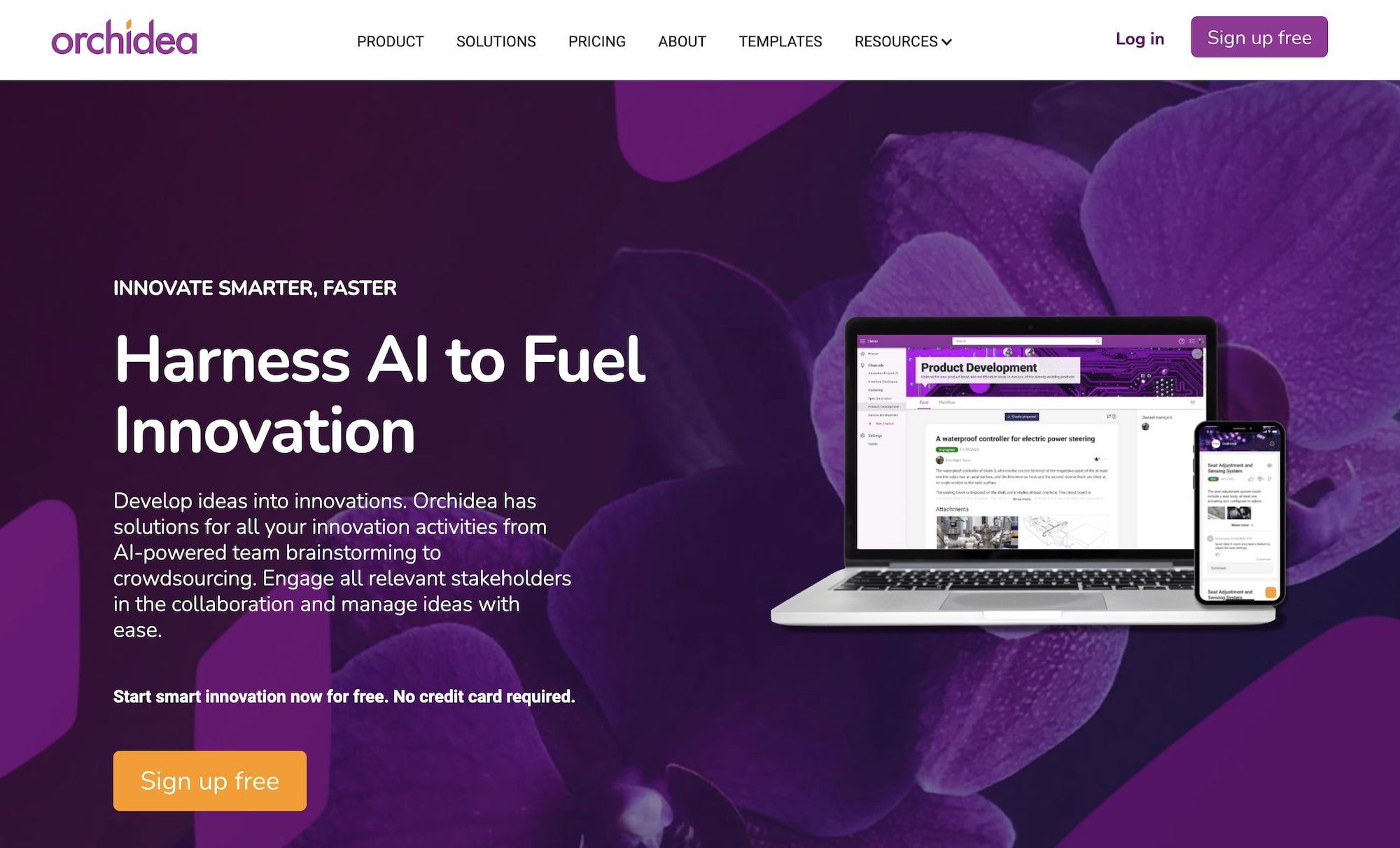
Orchidea is a comprehensive innovation management platform that allows users to collect ideas by creating and posting in-depth challenges.
Before onboarding, Orchidea’s customer success team meets with you on a call to discuss your innovation goals. On this call, they try to get an understanding of the types of ideas your innovation strategy requires. They then show you how to create challenges inside their platform and use email notifications to spark engagement.
Beyond challenges, Orchidea’s solution can be broken down into five key components:
Idea suggestion box — Innovation managers can use Orchidea’s suggestion box to collect a steady flow of ideas (outside of posting challenges).
Virtual brainstorming — Innovation managers can invite stakeholders and employees to join a call where everyone can share their ideas, work together to improve them, and decide which are worth testing.
Pre-made templates — Innovation managers can use Orchidea’s templates to launch brainstorming sessions and challenges instead of creating them from scratch.
Product development — Innovation managers can invite product managers and software developers to Orchidea and turn innovative product ideas into real-life software products.
AI-assisted idea generation — Innovation managers can automate ideation by telling the AI what company problems they are currently trying to solve, and the AI will recommend potential solutions. With this list of ideas, innovation managers can invite stakeholders and employees to discuss which ideas to toss out and which to pursue.
Pricing
Orchidea has a free plan that allows you to invite up to 15 members and create an unlimited number of challenges. If you want to invite more than 15 members, you’ll need to upgrade to one of the paid plans.
The paid plans include:
Team: $14/facilitator/month with up to 100 members.
Business: $395/month; includes 10 facilitators and unlimited members.
Professional: $735/month; includes 15 facilitators and unlimited members.
Enterprise: You’ll need to contact their sales team to discuss enterprise plans.
6. Yambla
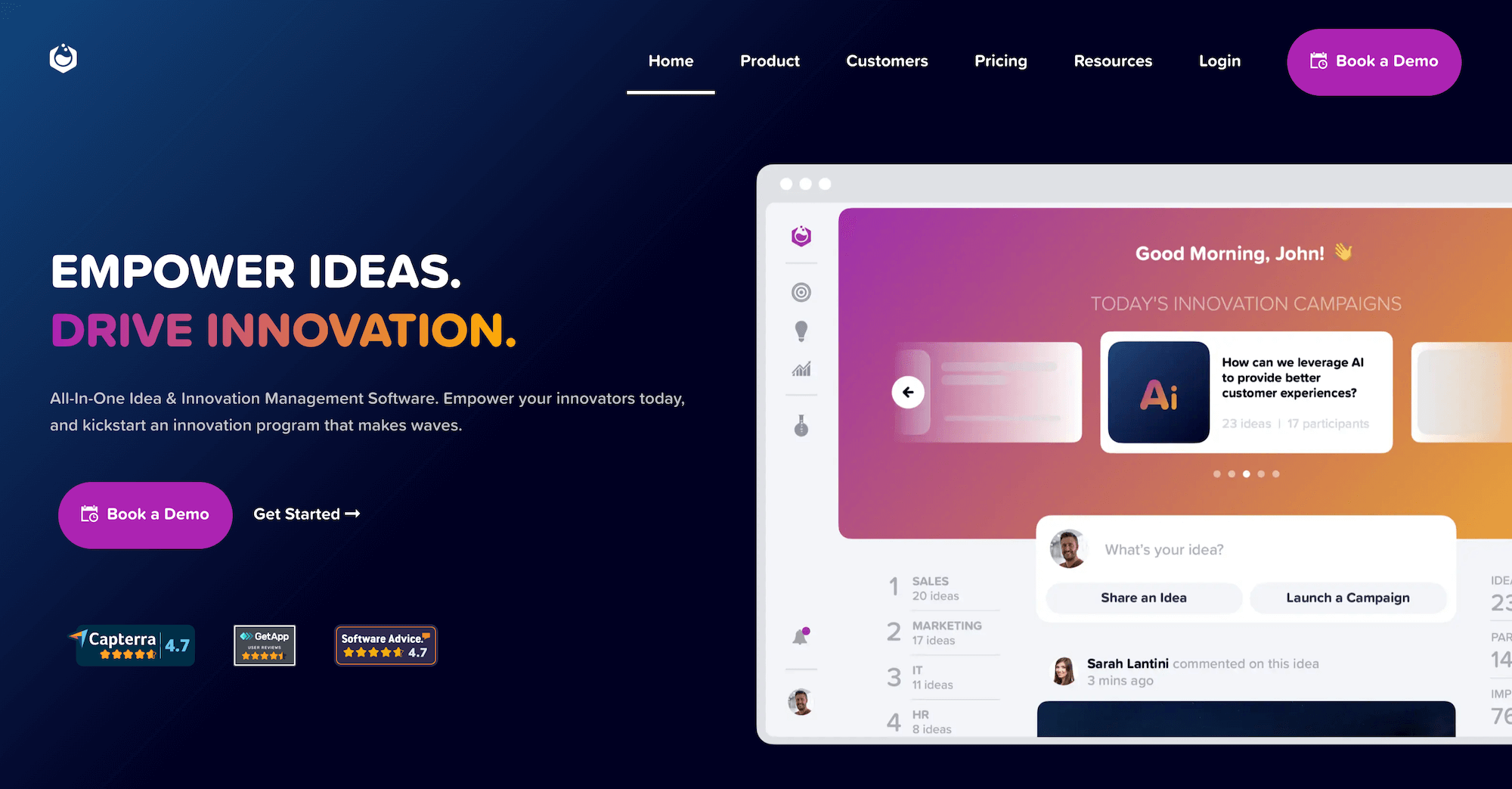
The final option on our list, Yambla, is an innovation management platform most popular with UK-based brands. This software has a comprehensive challenges feature where users can create postings and invite employees to submit their best ideas.
Yambla also allows users to add more detail to their challenges using attachments, FAQ sections, and various other documents. This ensures employees have the information they need to brainstorm and submit well-thought-out responses.
In addition to this challenges feature, users can access innovation management features that help test and implement ideas:
Idea management — Innovation managers can use Yambla’s idea management dashboard to see and organize all submitted ideas.
Idea crowdsourcing — Yambla encourages employees to continuously improve their ideas by allowing everyone to see submitted ideas and give feedback.
Hackathons — Innovation managers can use hackathon templates to plan the entire hackathon process, set goals that need to be achieved, and prompt employees to brainstorm and share ideas to achieve these goals.
Defined timelines — When pushing an idea into implementation, Yambla allows innovation managers to create defined timelines for each stage of an idea’s lifecycle. For example, innovation managers can set when the finance team needs to conduct a financial risk analysis or when the customer support team needs to interview customers, which helps keep innovation projects on track.
Pricing
Yambla currently has four pricing plans:
The Basic Plan costs €5,000 annually and allows you to host 500 users.
The Pro Plan costs €12,500 annually and allows you to host 1500 users.
The Premium Plan costs €20,000 annually and allows you to host 5000 users.
Yambla has custom plans which are available upon request.
Collect & Implement Innovative Solutions with InnovationCast
Schedule a free demo with our customer success team to explore InnovationCast’s Challenges feature further.
We’ll jump on a call and show you how to post challenges, leverage resources like articles, videos, and FAQs to educate employees about company goals, and receive more ideas relevant to your innovation strategy.

